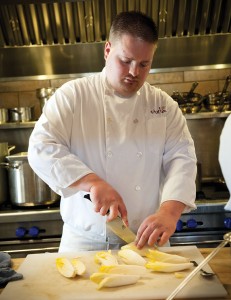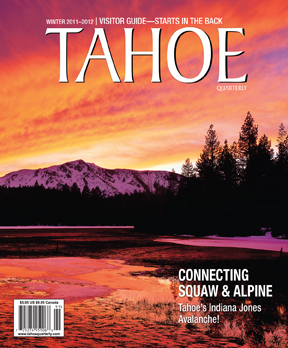Chef Jacob Burton on the Chopping Block
Q&A with Jacob Burton, executive chef at Truckee’s Stella
Interview by Susan D. Rock
A native of Cool, California, and graduate of California Culinary Academy, Chef Jacob Burton began his cooking career at Michelin-starred La Folie in San Francisco. A small-town guy at heart, he moved to North Lake Tahoe seven years ago, honing his craft at the Lone Eagle Grille, the Big Water Grille and Fredrick’s Fusion Bistro in Incline Village. He has served as executive chef at Stella at Truckee’s Cedar House Sport Hotel since 2010.
What is your earliest culinary memory?
A couple stand-outs are watching my great grandmother cook Portuguese food and watching Martin Yan on PBS. I was so obsessed with Yan Can Cook my parents gave me a cleaver for Christmas. It was a heavy meat cleaver instead of the lightweight vegetable version Martin Yan used, so they had to listen to me slam this four-pound bone crusher up and down on innocent vegetables for the better part of a year before they begged me to stop. I still use the cleaver to this day, albeit to break down whole pigs and lamb, not for cutting carrots.
Tell us more about your family.
I have a wife, Ana, and four-year-old daughter, Lyla. My younger brother Nathan is the front of the house manager and sommelier at Stella. He started off bussing and slowly worked his way up, learning a lot about wine, service and my style of cooking. It has turned into a unique, collaborative relationship and is part of the “secret sauce” continuing to drive Stella forward. My two other brothers, parents and extended family live in Auburn, Sacramento and the Bay Area.
How would you describe Stella’s style of cuisine?
The most appropriate category would be international/California cuisine. Some people would describe my menu as eclectic or “fusion,” but to me it’s a product of who I am. I was born and raised in California, which grows some of the best produce in the world and is an amazing melting pot of culinary culture, whether Latin, Asian, European, et cetera. My wife was born and raised in the Philippines, and I toured China for a month my senior year of high school, both of which have exposed me to (and reinforced my love for) Asian cuisine and culture.
At Stella, we cook food that excites us, whether it’s a riff on a known classic, a fusion dish from across the globe or a simple presentation of California produce at its peak.
What is your favorite kitchen tool/implement?
Stella’s wood burning oven is awesome for baking our naturally leavened bread for dinner service, our immersion circulator is great for precisely cooking certain proteins or vegetables for a consistent result and our industrial-strength pasta machine is important for making low hydration, alkaline noodles like ramen and soba (I broke two other pasta machines during my “ramen-obsessed phase” before we finally spent the money on a sturdier unit).
Why did you start your online cooking school, Stella Culinary?
When I started attending culinary school more than a decade ago, I remember how frustrated I was with the cooking information available. The Internet was loaded with recipes, but no one was teaching professional technique or the hows and whys behind cooking. If a recipe failed, it was hard to find information on why.
When I moved to Tahoe, I started the website FreeCulinarySchool.com to teach professional-level cooking technique through a series of audio podcasts and blog posts. When I was hired as the executive chef at Stella, owner Patty Baird really believed in my passion for teaching. We decided to rebrand Free Culinary School as Stella Culinary. Four years later, I have the equivalent of the first year of culinary school online for free: 21 podcast lectures and 160-plus videos demonstrating everything from knife skills, kitchen prep, bread baking and charcuterie to some classic Stella dishes, and even a few really geeky food science lectures.
StellaCulinary.com attracts about 50,000 unique visitors monthly from around the globe, from professional cooks looking to learn a new trick or talk shop on our forum to passionate home cooks.
How has your cooking style changed over time?
My style has simultaneously become simpler and more complex, as oxymoronic as that sounds. I love dishes that take lots of focus and technique to prepare, but are deceivingly simple on the plate. It can be tempting for chefs to create busy plates with lots of colors and garnishes, and occasionally that’s what a dish calls for. But a chef I used to work for always reminded me that “complexity hides flaws.” Often it’s more difficult to execute a simple dish perfectly, because there’s nothing to hide behind.
I think a good example of my style is the rabbit terrine currently on Stella’s menu. To me, the dish is beautiful because of its presented simplicity; the guest doesn’t need to know the time (three days) and toil that went into making it, just that it tastes wonderful, especially when enjoyed with a glass of Champagne.
What was it like being nominated for Food & Wine’s Best New Chef award last year?
It was really humbling, and honestly, something that took me a while to wrap my head around. Looking at the other chefs named by Food & Wine, I couldn’t help but feel I was out of my league. You would think an honor like this would be a big ego boost, but it actually made me question who I was as a chef, making me ask myself if I really deserved the nomination in the first place and if I could live up to the hype.
Without my sous chef, cooks, dishwashers, bussers, servers, sommelier or the support of the Cedar House, my job and any accolades that come with it wouldn’t exist. I’ve always taken pride in my work, and demand the same from every single person who works at Stella. The best part of the Food & Wine nomination was that an influential publication had taken notice of everyone’s hard work, in a location where it’s tough to be recognized on a national level in the first place. But we’re only as good as the last dish we serve, so every day we show up ready to do it all over again, trying to be just a little better than yesterday.
Reconstructed Berry Pie
by Jacob Burton
 This “reconstructed” berry pie is a simple play on a traditional favorite. I love macerated berries in the summertime, and who doesn’t like a good berry pie? This dessert takes half the work and a third of the time as a normal berry pie, and by rethinking its structure, allows you to keep your berries moist in a delicious simple syrup while keeping your crust crisp and flaky. Served in a martini glass, this recipe will make you a star at your next summer get-together.
This “reconstructed” berry pie is a simple play on a traditional favorite. I love macerated berries in the summertime, and who doesn’t like a good berry pie? This dessert takes half the work and a third of the time as a normal berry pie, and by rethinking its structure, allows you to keep your berries moist in a delicious simple syrup while keeping your crust crisp and flaky. Served in a martini glass, this recipe will make you a star at your next summer get-together.
Ingredients
1 lb Strawberries (cut into quarters)
½ lb Blackberries
½ lb Blueberries
4 ½ oz Lime juice (freshly squeezed)
4 ½ oz Sugar (granulated)
10 Basil leaves
Salt (for seasoning)
300 g/10.5 oz Flour
200 g/7 oz Butter (cubed)
100 g/3.5 oz Water (ice cold)
1 pinch Fleur de sel (or coarse sea salt)
4 oz Cream
½ t Vanilla extract (or the inside of a vanilla bean if you have it)
2 Eggs
Instructions
Berries
Combine quartered strawberries, blackberries and blueberries in a mixing bowl. Chiffonade the basil leaves into very fine strips. Add chiffonade basil, sugar and fresh-squeezed lime juice to the berries. The sugar should evenly coat the berries, while the lime juice brings the sweetness of the sugar into balance.
Pie dough
We use a simple 3-2-1 pie dough made popular by Michael Ruhlman’s book Ratio. Using this (metric) ratio allows you to scale the dough recipe up and down as needed, measuring your ingredients by weight for accuracy. Place the flour in a food processor with a pinch of kosher salt and add cubed butter on top. Pulse a few times so that the butter and flour slightly start to incorporate.
Slowly stream in ice cold water while hitting the “pulse” button (the secret to a flaky pie crust is having large, whole chunks of fat dispersed throughout the dough mixture). Mix dough quickly and just enough to incorporate all the ingredients but stop before it comes completely together. Turn dough out onto a clean countertop and immediately squeeze into a ball. Wrap in plastic and chill for 15 minutes (this will keep the butter from melting too much during the rolling process). Lightly dust work surface with flour and roll out the dough to a thickness of about a ¼-inch. (Anything thinner and the dough won’t flake properly when baked.) Roll the pie crust around a rolling pin and transfer to a sheet tray. Crack two eggs into a mixing bowl and beat briefly with a fork. Brush egg wash on top of the crust, sprinkle with some fleur de sel (or other sea salt) and bake in a 375º F oven for 25 to 30 minutes or until the pie crust is a rich golden brown.
Assembly
For the final plate-up, use either store-bought whipped cream (if you really must) or make your own by adding four ounces of cream, ½ teaspoon vanilla extract and enough granulated sugar to make it sweet to a mixing bowl. Whisk cream mixture by hand (or in a stand mixer) until firm peaks are formed. When you’re ready to plate, simply fill a polished martini glass with macerated berries and top with a dollop of freshly whipped cream. Break off a large piece of pie crust and stand up vertically in the whipped cream and berries. Serve immediately.
Find it online at www.stellaculinary.com/recipes/reconstructed-berry-pie-0
Category: Wine & Dine







